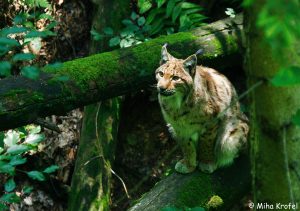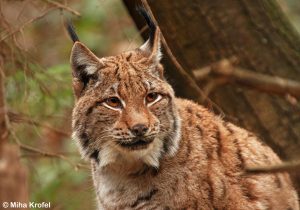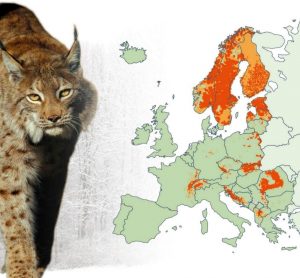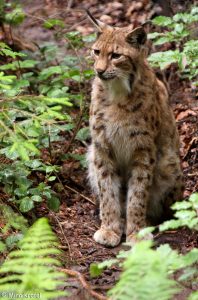
Foto: Miha Krofel
Lynx Extinctions in Europe
Over the last few centuries, the numbers of many species of carnivores have drastically declined. This situation is a direct or indirect consequence of human activity. Most carnivores come into conflict with man because of their predatory way of life.
Since the beginning of the historical era, the direction of the extinction process in Europe was from west to east. Extinction intensified after the Middle Ages, and peaked in the mid 19th century, when many local populations became extinct. The lynx first started to disappear from the lowland and coastal areas of today’s Denmark and Holland, as well as from most of the Polish/German lowlands. Around the year 1800 the lynx was present in the Alps, on the Balkan Peninsula all the way to Greece, in the Tatra Mountains, Carpathians and over the entire area of Eastern Europe, the Baltic States, Finland, and Scandinavia. There were several reasons for its disappearance, with different factors being predominant in different areas at different time periods. The persecution of large carnivores in Europe was well planned, legally organized and rewarded. It is hard to believe that the intensity and efficacy of hunting with the hunting tools available at the time is a factor that would by itself be capable of causing the extinction of lynx in Europe on such a scale.
From the 15th until the 17th century, open pasture, where livestock grazed over large surfaces throughout the entire pasture season, was the predominant method of pasturing in Europe. This exposed the livestock to attacks by large carnivores.
Cattle, sheep, horses and goats have been grazing in forests for centuries, thus inhibiting natural forest regeneration and turning forests into pastures. The amount of intensive agricultural surfaces increased dramatically with the introduction of new farming methods, new crops like potato, corn and sugar beet after 1734, and the introduction of livestock rearing in stables and pasturing on fenced-in pastures. Accompanying this was the rapid growth of the human population. This caused intensive clear-cutting of forests and habitat loss for lynx in all lowland or densely populated areas of Europe from the 14th century onward.
Previously inaccessible and closed forested areas were becoming intensively used, especially for charcoaling, as the need for charcoal, one of the most important energy sources besides firewood, grew rapidly with population growth. The intensive cutting of forests and the proliferation of forest roads, together with the development and use of firearms, also increased the intensity and efficacy of hunting, both of large carnivores and their prey.
The density of livestock in the 17th and 18th centuries was ten times greater than today. This, together with the then-common method of forest pasture, put livestock in competition with roe deer. The numbers of large herbivores declined dramatically over large areas of intensively used forests.
The larger part of the extinction process of lynx in Europe took place by the beginning of the 19th century. The collapse of the feudal society and the consequent liberalization of hunting privileges spelled the final extinction of lynx throughout most of Europe. At that time the density of large herbivores, especially roe deer, reached the lowest values ever in many parts of Europe. The number of roe deer in Slovenia in the first half of the 19th century is estimated at about 1% of the contemporary figure, while red deer and wild boar became near extinct.
By the end of the 18th or the beginning of the 19th century, the bottleneck effect became more and more apparent. Reproductive success and survival of the young animals were additionally reduced as a result of extremely poor feeding conditions, which were crucial for their survival. In the 19th century, the importance of direct hunting on the lynx extinction process, both in Slovenia and Europe as a whole, was probably secondary. There were thirty-eight lynx killed in Slovenia in the 19th century. The direct cause of extinction of local populations in Europe in the 19th century was primarily fragmentation and poor feeding conditions in the lynx’ habitat.
Sources:
Kos I., Potočnik H., Skrbinšek T., Skrbinšek M.A., Jonozovič M., Krofel M. 2004. Ris v Sloveniji. 1. izd. Ljubljana, Biotehniška fakulteta, Oddelek za biologijo: 239 str. (Lynx in Slovenia. Ljubljana, Biotechnical Faculty, Department of Biology. 239 pg.)

Foto: Miha Krofel
Lynx Re-introduction in 1973
In the beginning of the 1970s in the Rog Hunting Reserve in South Slovenia, today known as the Medved Hunting Reserve, an idea to reintroduce the lynx in the Kočevska region as a hunting species came into being, sparked by a guest hunter from Switzerland, Karl Weber. In January 1973, three male and three female lynx were brought into a quarantine enclosure from a quarantine in the Zoo Ostrava, Czechoslovakia. Snow tracking of presumably all six animals was then reported in November 1973. The females still remained in the Kočevski Rog area, while the males already appeared further west in Mala gora and Velika gora. Two of the females had one kitten each, while another one had two kittens. In the following years the population grew and expanded. The initial development of the population shows low mortality of individuals. This was of key importance for the survival of the newly-established population through the initial phase. A major role in the success of the lynx reintroduction is attributed to the positive attitude of hunters towards the reintroduction and to the fact that feeding conditions were favourable.
The population continued to grow, despite planned culling after 1978. The population also expanded in the north-western direction towards Italy and the Alps, as well as towards the south-east to Bosnia and Herzegovina. Vigorous population growth and range expansion during the initial fifteen years was followed by what seemed like a period of stabilization in the late 1980s and early 1990s. The year 1986 marked the beginning of an absurd campaign for open culling of lynx in the so-called non-classified areas. This measure stopped further expansion of lynx into other suitable parts of Slovenia. In the 1990s, lynx were present over the south-western half of Slovenia, all the way to the western mountains of Bosnia in the south-east.
Inbred Population
The trend of this success story turned downwards in the last ten to fifteen years, with the lynx population decreasing. Today the Dinaric-SE Alpine lynx population is in decline and is strictly protected over its entire range. Contact with the Alpine and the Balkan lynx populations has not been thoroughly researched yet, but given the geographic distances and landscape barriers, the offspring of the six reintroduced animals were likely reproducing in isolation for the last forty years.
In small and isolated populations like this, alleles are randomly fixed or lost due to genetic drift, and deleterious mutations accumulate because of less effective selection. In the long term, these processes erode quantitative genetic variation necessary for adaptive evolution. Additionally, recessive deleterious alleles become exposed phenotypically because of increasingly homozygous individuals. All this can lead to reduction of fitness, termed inbreeding depression. Inbreeding can have negative consequences on all aspects of reproduction and survival, and increases the risk of extinction.
Sources:
Kos I., Potočnik H., Skrbinšek T., Skrbinšek M.A., Jonozovič M., Krofel M. 2004. Ris v Sloveniji. 1. izd. Ljubljana, Biotehniška fakulteta, Oddelek za biologijo: 239 str. (Lynx in Slovenia. Ljubljana, Biotechnical Faculty, Department of Biology. 239 pg.)
Sindičić M., Polanc P., Gomerčić T., Jelenc M., Huber Đ., Trontelj P., Skrbinšek T., 2013. Genetic data confirm critical status of the reintroduced Dinaric population of Eurasian lynx. Conserv Genet. DOI: 10.1007/s10592-013-0491-x: 10 str.

Foto: Miha Krofel
Genetic Problems of Small Populations
The viability of a population tells us the probability of the population avoiding extinction over a certain time period. Random or stochastic events that affect the viability of populations are demographic stochasticity, environmental stochasticity, genetic stochasticity and catastrophic events. The viability of small populations is usually lower, as they are more sensitive to stochastic events. Many European lynx populations are small and isolated. This makes them vulnerable to several factors that can significantly decrease their viability. The founder effect has an important impact on some genetic characteristics of a population. Founder effect is the loss of genetic variation that occurs when a new population is established by a very small number of individuals from a larger population.
Because of the low effective size of the population, genetic diversity is declining due to genetic drift. Such populations are vulnerable to additional threats, which do not represent problems for larger populations. In such a small population as in the Dinarics, every single mortality greatly increases the likelihood of extinction. With each death of an individual, there is also a further decline in reproduction.
Sources:
Kos I., Potočnik H., Skrbinšek T., Skrbinšek M.A., Jonozovič M., Krofel M. 2004. Ris v Sloveniji. 1. izd. Ljubljana, Biotehniška fakulteta, Oddelek za biologijo: 239 str. (Lynx in Slovenia. Ljubljana, Biotechnical Faculty, Department of Biology. 239 pg.)
Vlada RS. 2016. Strategija ohranjanja in trajnostnega upravljanja navadnega risa (Lynx lynx) v Sloveniji 2016–2026: 41 str.
http://www.mop.gov.si/fileadmin/mop.gov.si/pageuploads/podrocja/velike_zveri/strategija_ris_2016_2026.pdf (December 2016)
Distribution in 2012

| Population name | Countries | Size (c. 2012) | Trend |
| Scandinavian | Norway, Sweden | 1800 – 2300 | Stable |
| Karelian | Finland | 2400-2600 | Increase |
| Baltic | Estonia, Latvia, Lithuania, Poland, Ukraine | 1600 | Stable |
| Bohemian-Bavarian | Czech Republic, Germany, Austria | 50 | Stable or decrease |
| Carpathian | Romania, Slovakia, Poland, Ukraine, Czech Republic, Hungary, Serbia, Bulgaria | 2300-2400 | Stable |
| Alpine | Switzerland, Slovenia, Italy, Austria, France | 130 | Stable |
| Jura | France, Switzerland | 100 | Increase |
| Vosges Palatinian | France, Germany | 19 | Stable or slight decrease |
| Dinaric | Slovenia, Croatia, Bosnia & Herzegovina | 120-130 | Stable or decrease |
| Balkan | “the former Yugoslav Republic of Macedonia”, Albania, Serbia (incl. Kosovo*) | 40-50 | Decreasing? |
Sources:
Large Carnivore initiative for Europe IUCN/SSC specialist group. 2012. Eurasian lynx.
http://www.lcie.org/Large-carnivores/Eurasian-lynx (December 2017)

Foto: Miha Krofel
Threats
- Inbreeding and other problems due to the small population size
- Habitat fragmentation
- Low social acceptance
- Poaching
- Decrease of suitable habitat
- Mortality due to vehicle collisions
Sources:
Strategija ohranjanja in trajnostnega upravljanja navadnega risa (Lynx lynx) v Sloveniji 2016–2026: 41 str.
http://www.mop.gov.si/fileadmin/mop.gov.si/pageuploads/podrocja/velike_zveri/strategija_ris_2016_2026.pdf (December 2017)
The IUCN Red List of Threatened Species. 2017. Lynx lynx. http://www.iucnredlist.org/details/12519/0 (December 2017)
Regulations for Lynx Conservation
International Regulations
- The IUCN Red List of Threatened Species
- The Convention on Biological Diversity
- The Washington Convention on International Trade in Endangered Species of the Wild Fauna and Flora (CITES) (monitors the trade in wild animals and plants)
- The Bern Convention (an agreement for the preservation and protection of European wild plants and animals and their habitats)
- The Pan-Alpine Conservation Strategy for the Lynx
- Alpine Convention
European Legislation
- Council Directive 92/43/EEC of 21. May 1992 on the conservation of natural habitats and of wild fauna and flora (The Habitats Directive)
- Regulation (EC) No 338/97 — regulating trade so as to protect species of wild fauna and flora
